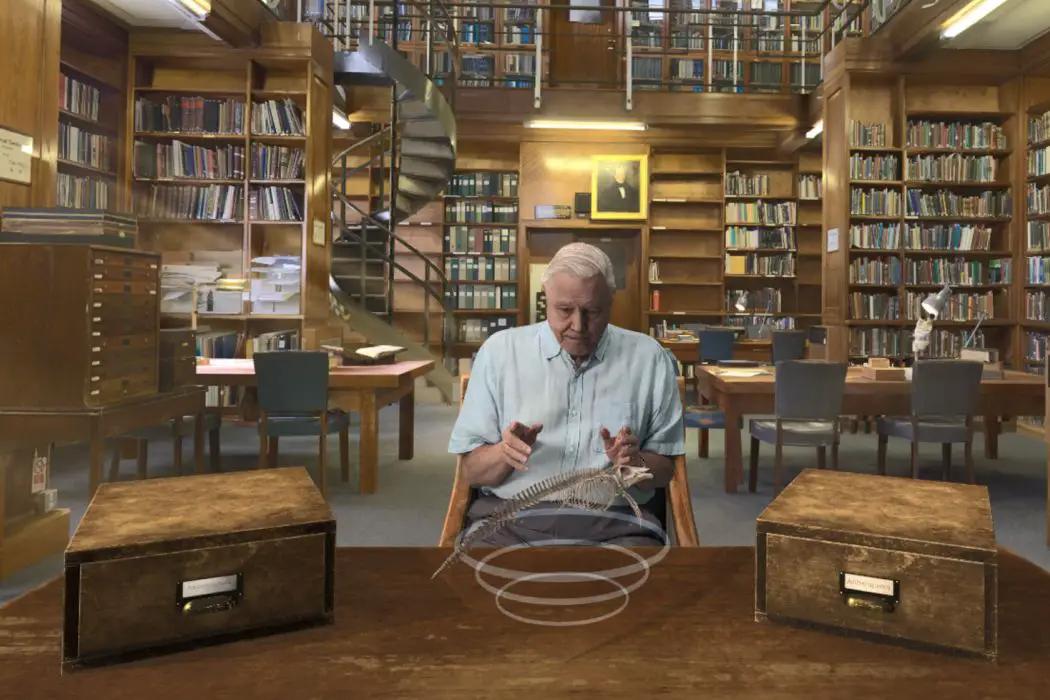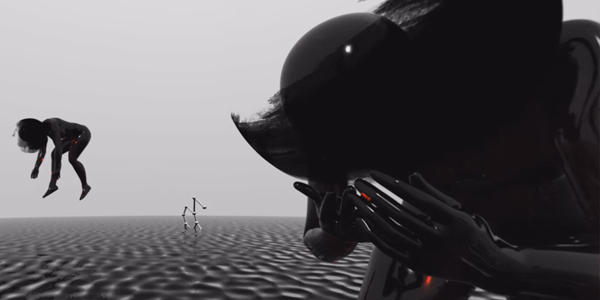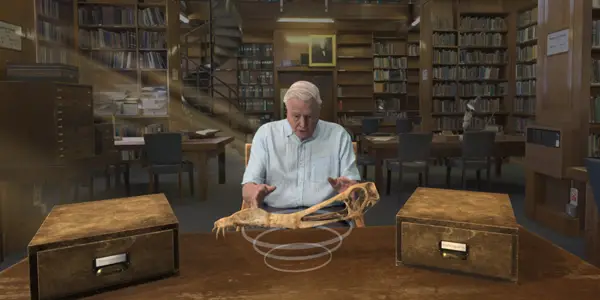SXSW: The Virtual Reality Future

Jax is a filmmaker and producer, and a film &…
Let’s lay the cards on the table right away: I’ve been a long time skeptic of virtual reality, especially as it applies to cinema. Heading into SXSW Conference and Festivals, I had a tendency to lump Virtual Reality / Augmented Reality (VR / AR) in with 3D as something gimmicky and unnecessary. I just could not see the point in laying out several hundred bucks for what I presumed was a glitchy technology that was not going to enhance my viewing experience in any substantial way.
Still, I was interested to see where the technology was headed and what kind of impact it would have on the average cinema-goer. All of the major festivals from Sundance to SXSW even to Cannes have dedicated significant chunks of their program to VR/AR, so presumably, this is a thing now. But for those of us who are not early adopters or can’t be bothered to shell out for the high-end Virtual Reality home devices, what can we expect VR/AR to bring to our everyday experiences?
I decided to jump in feet first and talk to some of the people who would actually know this answer, so I met up with several different artists and technicians while I slunk my way around the massive VR/AR space that SXSW dedicated in Austin’s JW Marriott. This exhibit space had some of the longest waits in any area of the festival – we’re talking 6-8 hour waits for a 14 minute Virtual Reality experience – so it’s safe to say it was popular.
Whole New Worlds
Joining the throngs of tech-enthusiasts that descended upon the Marriott, I wound my way up the three escalators to the top floor where the VR/AR exhibit was housed. I fully expected just to see lots and lots of people in Oculus headsets paying no attention to the world around them, and there was a fair amount of that, but this was SXSW and some of the display artwork was stunning on its own and helped create a much more interesting as well as friendly vibe.
After nosing through the various stalls offering everything from games to films to installations to educational tools, I set my sights on the large central booths taken over by Technicolor. The veteran company which seems to have branches in just about every media-related field allowed me to try the two Virtual Reality products they were proudly presenting at the festival.

The first, and my personal favorite, of the two, was Four Worlds, a truly innovative approach to combining music and visual art. A combination of composed music, animated visuals, and haptic cues create four distinct short experiences or “worlds”. Though they each start and end much like a film, I hesitate to describe them as such because the element of user/viewer control has such a real and noticeable effect. For instance, moving your head might create a sunrise or sunset or change the speed of the music. It’s also worth noting that my concerns surrounding my glasses were mollified instantly – everything played fine and focused well.
For the record company behind the music, surprisingly, Virtual Reality didn’t seem like a huge leap. Christine Colbert of Warp Records told me that a lot of their artists are becoming more and more interested in using technology to interact with their fans:
“The music industry has shifted a lot in the last several years, with digital, streaming, and stuff like that…It’s getting more and more technologically enmeshed…so this is definitely territory that we see ourselves moving further into it and it’s just another way…for fans to experience the music.”
It was this piece that helped me begin to understand just how different Virtual Reality was from what I came into it thinking. I had thought of it as an addition to cinema, but I was learning, very quickly, that the creators and innovators behind VR see much bigger things in its future. Not only that, as an art form, VR expands on more than just one arena.
Where I had come in expecting mostly VR films and games, the first thing I ended up checking out was a VR album! And I didn’t find it totally pretentious! It seemed to be a totally natural expansion on the music, with both the visual and audial existing independently of each other but working together to give the user something new.
I was able to track down Brian Frager of Technicolor to talk about his thoughts on VR’s role in art, and how crucial it is to view it as separate from the cinema. Frager told me,
“…with VR I think… it’s an emergent medium that happened in the last 20 years and that’s about where the comparison [to 3D] is done for me because a virtual reality and interactive storytelling and immersive storytelling is a whole new medium. And so, you know, cinema will live on and I love it dearly and this new medium needs to find a language of its own that’s just being developed.”
This developing language certainly makes it difficult to discuss VR without relying on the language of other media. In a sense, Virtual Reality fits perfectly into McLuhan’s ideas around remediation – it certainly has been birthed and developed out of the cinematic and gaming worlds, and some of the experiences on offer more clearly betrayed these roots than did Four Worlds.
The second VR ‘experience’ from Technicolor, MONO: Blackwater, reminded me more of an extremely immersive and quite artistically rendered cutscene in a video game. This “transmedia” story, done in collaboration with Madefire, follows main character MONO, a “former assassin to the queen and legendary apeman” after he returns from exile and must challenge shadowy organization The Fold.
MONO: Blackwater is considerably less immersive than Four Worlds insomuch as the user is a relatively static and inconsequential witness to the proceedings of the cutscene. In that regard, the experience felt far more filmic, and is the result of an effort to bring the story of MONO to a variety of media for fans to consume.
According to Frager, “It’s a transmedia story, right? It can exist pieces in VR, pieces in comic books, pieces in film, traditional cinema, and each medium is optimized for a certain type of experience within that world. But really what you’re doing at the end of the day is world building. And I think fans and consumers want to experience the worlds that they engage with in whatever form they can.”
As I walked away from the Technicolor booths, my brain gently exploded. I mean, nobody likes to admit they are wrong, right? That was what I was very seriously considering, so I decided I had to check out more content to prove myself right.
I Was Wrong
So very wrong. But let’s backtrack a bit. After seeing what a large company like Technicolor presented to the festival, my keenest interest was in something independent. This served a dual purpose of ensuring almost no wait time while allowing me to see what people accomplished with much more limited resources. Wandering over to the far reaches of the conference room, there was a slew of stalls with nobody around. I moseyed up to a little booth that had two phone compatible headsets hooked into Samsungs.
Student film Tiniest Tremor by Nick Brewer and Megan Simon is a stunning Virtual Reality animated documentary about the opioid crisis, specifically Neonatal Abstinence Syndrome. The voice of Cassie, a recovered addict who now works as an addiction counsellor, tells the story of giving birth to her son, who came into this world addicted to heroin. This audio meets with the stunning surreal animations by Megan Simon, draping the user in a monochromatic world with fragile, non-sequential bodies slowly rising out of a tarlike ocean.

The co-directors use the entire 360-degree space provided to them (something I actually felt was missing from some of the Technicolor projects) and this results in shocking moments. If and when the user chooses to turn, they may be confronted by a new body, or as I was at a pivotal moment, a large infant. In just three minutes, the weight of this tragic epidemic and Cassie’s personal journey was fully upon me. The abstraction and immersion of the animation absolutely reinforced the impact and it was all the more impressive that I was watching on something available at the consumer level.
It was very clear that these directors consider this a “VR film” and not a “film that uses VR”. It begs the question – would this be as effective if it wasn’t VR? Co-director, Megan Simon explained it to me:
“We chose VR because we felt that the story with addiction, there’s a lot of stigma, and we wanted to create a more intimate experience. We felt those barriers between the viewer and having empathy towards the story. And so the first step to overcoming that barrier was making it VR and then the next step was to make an animated and to make it more minimalistic animation because that allows people to project their own experiences in a way where they wouldn’t if it was a person, like talking heads.”
The emphasis on visualization is apparent, but the use of the 360 space truly separates this from merely being an animated documentary and brings it fully into the Virtual Reality realm. This imputes an element of choice onto the user, something that could potentially intimidate many filmmakers. Simon, however, was unfazed:
“It’s difficult, but I also kind of enjoy it because I feel that I’m not just designing one viewpoint…And I found that that not only gives people freedom to look where they’re interested in therefore worth when they’re projecting their own experiences and having more empathy for Cassie. It also gives me, I guess, more creative freedom to play with space. And I enjoyed that a lot.”
This meshes pleasantly with Brewer’s attitude toward his role in making the film, which was predominantly gathering the interview and working directly with Cassie:
“I have a background in anthropology and the first thing that I like know, the first thing they teach you is that when you enter a new situation, you just shut up and listen and be quiet and you just pay attention and observe. And I knew immediately without even having the same much that this was a story that needed to be told and the only thing that I could really do in that moment was to just let her tell it.”
Tiniest Tremor is the kind of film that sat with me and percolated for a long time. The visuals, the story itself, the immersion – it all needed to settle and find its way somewhere within that ultimately left me incredibly moved. Before this, I had somewhat scoffed at the notion of VR documentary, thinking that it simply couldn’t be that interesting for the user/viewer or at least not accomplish anything that film on its own could not do. Like I said, I was wrong, and the day wasn’t even over.
Education
Feeling considerably emotionally beaten up and swallowing what remained of my pride, I left the Tiniest Tremor booth impressed but on the hunt for something totally different. My only disappointment with what I had been experiencing was that it had, so far, been entirely passive, and what Brian Frager had excited me about with Virtual Reality was the potential for full immersion and interaction. Luckily, I didn’t have to look far because directly across from Tiniest Tremor was a collaboration from Sky and Factory42 featuring (cue gasp) Sir David Attenborough.

Hiding my inner Blue Planet fangirl, I approached the incredibly friendly Factory42 team and managed to squeeze in a spot to check out HOLD THE WORLD, “a one-on-one audience with David Attenborough at the Natural History Museum.” In the short demo that I got to try, Sir David Attenborough politely sat across from me at a table in the museum and guided me through examining a blue whale skeleton. The VR tech allowed me to zoom right in on the bones while Attenborough explained what I looked at, and then immediately scaled the skeleton up to full size. It was quite breathtaking, to be honest.
The combination of motion-capture and animation creates an incredibly realistic and immersive world so that when the whale becomes full scale, the sense of size is truly something to behold. The argument, of course, is that this is nothing like the real thing. I don’t disagree, however, I left incredibly excited by the technology and what it means for educational access in remote and/or underfunded communities.
The cost of a Virtual Reality headset pales in comparison to the cost of securing and housing a full blue whale skeleton. This aspect of the technology was the most inspiring and uplifting for me personally, and I think it’s where we’ll see the biggest immediate impact from VR in our communities.
An Eye-Opening Adventure
After a few days of wandering around the upper floor of the Marriott in Austin, I finally left the conference room for good, thoroughly dazed and impressed. The possibilities which had seemed so limited previously now stretch out in front of all of us. Already, there are facilities opening up around the world where entire rooms are mapped into a Virtual Reality experience and you may go (with a group if you wish) and temporarily live out an entirely different world.
Whether as a means of entertainment, education, or art, what became clear to me on my trip to SXSW is that Virtual Reality is no passing fancy. As the technology continues to develop, it seems clear that VR and AR will integrate ever more into our day to day lives and we must begin finding the terms by which we understand it as its own art form while we heed the warnings of eXistenZ.
Does content like this matter to you?
Become a Member and support film journalism. Unlock access to all of Film Inquiry`s great articles. Join a community of like-minded readers who are passionate about cinema - get access to our private members Network, give back to independent filmmakers, and more.
Jax is a filmmaker and producer, and a film & tv production lecturer at the University of Bradford and is also completing a PhD about Stan Brakhage at the University of East Anglia. In the remaining "spare time", Jax organises the Drunken Film Fest, binges bad TV, and dreams of getting “Bake Off good” with their baking.













